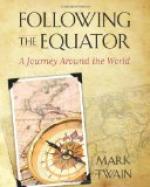Mr. Philip Chauncy, an officer of the Victorian Government, contributed to its archives a report of his personal observations of the aboriginals which has in it some things which I wish to condense slightly and insert here. He speaks of the quickness of their eyes and the accuracy of their judgment of the direction of approaching missiles as being quite extraordinary, and of the answering suppleness and accuracy of limb and muscle in avoiding the missile as being extraordinary also. He has seen an aboriginal stand as a target for cricket-balls thrown with great force ten or fifteen yards, by professional bowlers, and successfully dodge them or parry them with his shield during about half an hour. One of those balls, properly placed, could have killed him; “Yet he depended, with the utmost self-possession, on the quickness of his eye and his agility.”
The shield was the customary war-shield of his race, and would not be a protection to you or to me. It is no broader than a stovepipe, and is about as long as a man’s arm. The opposing surface is not flat, but slopes away from the centerline like a boat’s bow. The difficulty about a cricket-ball that has been thrown with a scientific “twist” is, that it suddenly changes it course when it is close to its target and comes straight for the mark when apparently it was going overhead or to one side. I should not be able to protect myself from such balls for half-an-hour, or less.
Mr. Chauncy once saw “a little native man” throw a cricket-ball 119 yards. This is said to beat the English professional record by thirteen yards.
We have all seen the circus-man bound into the air from a spring-board and make a somersault over eight horses standing side by side. Mr. Chauncy saw an aboriginal do it over eleven; and was assured that he had sometimes done it over fourteen. But what is that to this:




